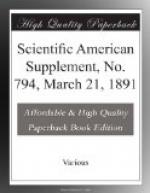On cracking the phenoloid oil, the paraffins yield ethane, propane, and marsh gas, etc., in the usual way, while the phenol interacts with the carbon to form benzene—
Phenol. Benzene.
C6H5HO + C = C6H6 + CO.
And in the same way the cresol first breaks down to toluene in the presence of the carbon, and this in turn is broken down by the heat to benzene.
A great advantage of this oil is that the flashing point is 110, and so is well above the limit, thus doing away with the dangers and troubles inseparable from the storage of light naphtha in bulk.
In using this oil as an enricher, it must be cracked in the presence of carbon, and it is of the greatest importance that the temperature should not be too high, as the benzene is easily broken down to simpler hydrocarbons of far lower illuminating value. This fact is very clearly brought out by a series of experiments I have made, in which the phenoloid oil was cracked by passing it through an iron tube packed with coke and heated to various temperatures, the hydrocarbons being much more easily broken up under these conditions than if mixed with diluents, such as water gas:
RESULTS OBTAINED ON CRACKING PHENOLOID OIL.
I. II. III.
Temperature. 600 deg. C. 800 deg. C. 1,000 deg. C. Volume of gas per gallon. 41.6 c.f. 76.8 c.f. 121.6 c.f.
COMPOSITION OF THE GAS.
Hydrogen. 34.0 36.0 37.0 Methane. 20.0 26.0 49.0 Olefines. 11.0 5.0 Nil. Ethane. 16.0 9.0 Nil. Carbon monoxide. 13.0 15.0 12.0 Carbon dioxide. 2.0 4.0 2.0 Oxygen. 2.0 1.0 Nil. Nitrogen. 2.0 4.0 Nil.
This analysis shows that if the temperature is allowed to reach a cherry red, complete decomposition of the illuminating hydrocarbons is taking place, and a gas of practically no illuminating value results. The power of regulating the temperature and the body of carbon as a cracking medium in the Van Steenbergh water gas plant especially fits it for using this oil, and removes the objections which could have been urged against the lighter naphthas.
This oil is at present not in the market, but given a demand, it can be produced in four months, at the latest, in very large quantities, as the apparatus is very easy and cheap to erect, and the crude material can be plentifully obtained.




